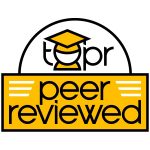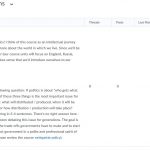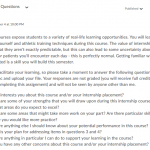Tags: Assignments, Content, Discussions, Engagement, Equity, Interaction, Introduction, Peer-Reviewed Entry, Quizzes, Social Presence, Support

Description
Student introductions are a high-impact practice: they build community within the course, set the stage for more substantive forms of student-student and student-instructor engagement, and can reveal unknown issues or strengths on the part of students (Dolan, Kain, Reilly, & Bansal, 2017). Building community in online classes (Nelson & Goodson, 2018) through introductions helps create the social presence (Aragon, 2003; Garrison, Anderson, & Archer, 2000) needed for course success, learning, and retention (Angelino, Williams, & Natvig, 2007). Accordingly, most online course quality evaluation rubrics (Quality Matters, OSCQR Course Design Review Scorecard, CSU Quality Learning and Teaching instrument) reinforce community and introductions. Moreover, accreditors expect courses with robust engagement, but these levels can be difficult to achieve without a strong sense of class community; student introductions are a key element in meeting these expectations.
Student introductions are a rich opportunity for students to begin thinking about course content; to share a contextual, multi-dimensional side of themselves; and for the instructor to gather information that supports student success.
Example
Creating Meaningful Introductions in Two Steps
We argue for a two-step student introduction process: 1) a whole-class posting in response to a meaningful, course-specific question, and 2) an instructor-only introduction in which a student has the opportunity to disclose any potential challenges they may face in the course. In creating this two-step course introduction, instructors should share the rationale for each type of introduction opportunity.
Whole-class Introduction
A first option is a course-specific introduction prompt that invites students to think about themselves in relationship to course content, but this prompt must not require content knowledge that students don’t yet have. For example, a writing course might ask students where or when they do their best writing; a pediatric nursing course might ask students for their best tip for interacting with children in any setting; a marketing course might ask students for a favorite advertisement and why it was so memorable. These focused prompts allow students to get to know each other in the context of course material. This allows the instructor and other students to step away from the demographic characteristics of an individual, decreasing some of the potential for implicit biases and judgments about anything a student might reveal in response to a vague, general prompt. Students have rich lives outside of the course and those details can build community—or communities—among some students, but leveraging a course introduction toward building a whole-class community about course content provides a far more equitable start. (See Artifact 1: Political Science Introduction)
A second option asks students to post a video introduction of themselves where they state their name and respond to a prompt that is either generic or course-specific. In addition to personalizing each student, the recording of the student’s name allows the instructor and other students to practice the pronunciation of the name in advance of video conferences, face-to-face sessions, or video feedback recordings (Jones-Roberts, 2018). Unlike a content-focused introduction prompt, the video approach does not obscure identifying demographic details—indeed, students’ children, pets, or other elements particular to their lives may appear in the video. (See Artifact 2: Communication Introduction)
Whichever option an instructor chooses, the instructor should model with an initial post and craft thoughtful discussion guidelines to direct students about how to respond to their peers’ posts.
Instructor-only Introduction
To further develop community, a second introduction seen only by the instructor provides a chance to ask students specific skill-based questions or for students to identify potential concerns. This gives the instructor the opportunity to offer direction and resources should challenges arise. This second introduction item could be accomplished through different formats depending upon the instructor’s needs or preferences.
The first format option is an assignment submission. If instructors use a Q & A format, they could create a template students download and complete. If instructors prefer a series of prompts, students could upload their self-generated document. In English, this could take the form of a writing history letter where students articulate their past encounters with writing and how those have influenced how they view themselves as writers. It could be a reflection and projection narrative where nursing students examine how their hospital experiences or work might be brought into coursework or projects. For a marketing course, students with work or internship experience could examine connections or specializations they might be interested in exploring. (See Artifact 3: Athletic Training Internship Introduction).
The second format option is a quiz. Instructors can have a multiple-choice question with each of the different assignments listed and ask students to choose the assignment that most appeals to them. Conversely, they might ask the students which assignment they are most uncertain about and follow this with space for students to explain what specifically gives them pause. Instructors should reinforce that this is not a formal quiz, but that they are using the tool to help collect information. By examining the student responses on a question-by-question basis, instructors might identify common patterns. (See Artifact 4: French Introduction)
Both of these instructor-only introduction options provide the instructor with the chance to leave student-specific comments. If a student identifies a concern, the instructor now has the opportunity to offer resources early, taking a more proactive approach. For example, a student might indicate that they are most worried about the amount of writing in the course because they always struggle coming up with ideas. The instructor can then suggest the student schedule a meeting as the first project is introduced or explain that students will be sharing their ideas with peers and receive instructor feedback before moving forward. This builds the student-instructor connection before the student receives formative feedback about coursework, further developing one aspect of social presence by creating a dialogue with the student that is friendly and personalized.
Conclusion
While there is no formula for a perfect course introduction, this two-step approach (Whole-class and Instructor-only) honors the two community relationships that characterize the course. The whole-class class introduction is a powerful tool for instructors and peers to get to know each other within the context of the course. By adding an instructor-only introduction, instructors can gather specific information or data needed to create a customized learning experience for that course and those specific students. This two-step introduction will yield benefits in terms of increased student engagement and a more robust classroom community.
Link to example artifact(s)
- Figure 1: Political Science Introduction (image)

- Figure 2: Communication Introduction (image)

- Figure 3: Athletic Training Internship Introduction (image)

Link to scholarly reference(s)
Angelino, L. M., Williams, F. K., & Natvig, D. (2007). Strategies to engage online students and reduce attrition rates. Journal of Educators Online, 4(2), 1–14.
Aragon, S. R. (2003). Creating social presence in online environments. New Directions for Adult & Continuing Education, (100), 57–68.
Dolan, J., Kain, K., Reilly, J., & Bansal, G. (2017). How do you build community and foster engagement in online courses? New Directions for Teaching and Learning, 2017(151), 45-60.
Garrison, D. R., Anderson, T., & Archer, W. (2000). Critical inquiry in a text-based environment: Computer conferencing in higher education. The Internet and Higher Education, 2(2–3), 87–105.
Jones-Roberts, C. (2018). Increasing social presence online: Five strategies for instructors. Distance Learning for Educators, Trainers, and Leaders, 15(2), 47–50.
Nilson, L. B., & Goodson, L. A. (2018). Online teaching at its best: Merging instructional design with teaching and learning research. San Francisco, CA: Jossey-Bass.
Citation
Schmidt, J., & Marshall, K. (2020). Create intentional communities through meaningful student introductions. In A. deNoyelles, A. Albrecht, S. Bauer, & S. Wyatt (Eds.), Teaching Online Pedagogical Repository. Orlando, FL: University of Central Florida Center for Distributed Learning. https://topr.online.ucf.edu/create-intentional-communities-through-meaningful-student-introductions/?rev=4302.Post Revisions:
- July 30, 2020 @ 19:31:48 [Current Revision]
- June 11, 2020 @ 01:31:11
- March 4, 2020 @ 20:19:13

